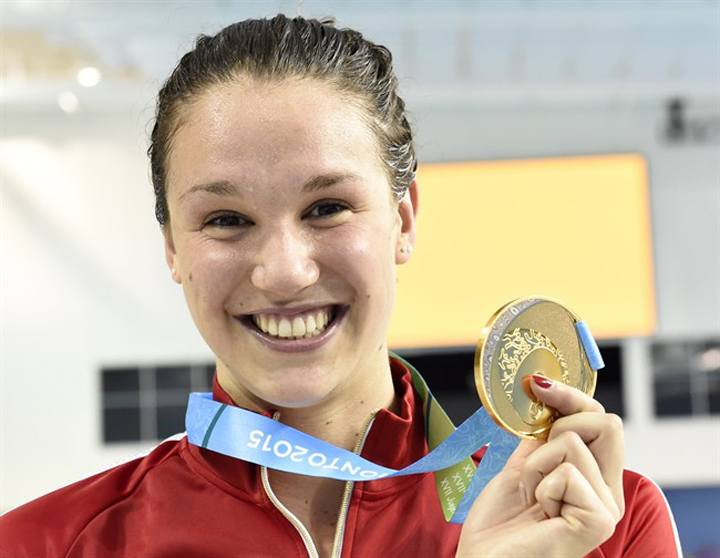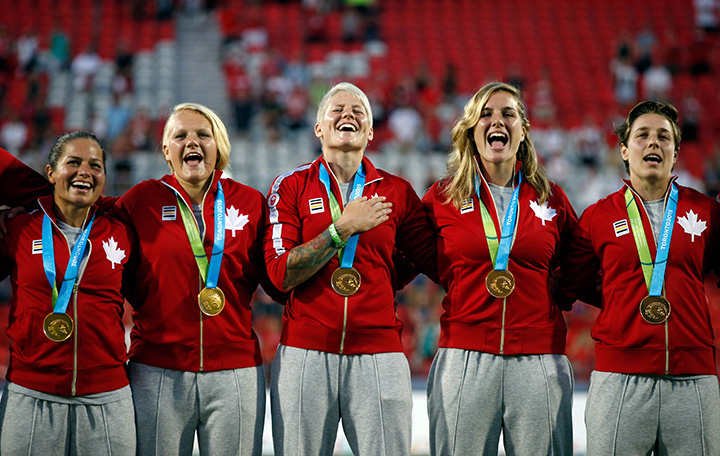Canada’s 750 athletes at the Pan Am Games in Toronto have racked up 64 medals after four days of competition, placing them at the top of medal count with 64 medals.

The sports at the Pan Am Games are similar to the Summer Olympics – sports where Canada generally doesn’t do so well. Canada only won 18 medals at the 2012 Olympics and only one gold, placing us 36th in the medal standings.
So what’s changed? The competition, for one, is on a different level. European and Asian athletes aren’t competing, which in relation to other nations, elevates the competitiveness of the Canadian team.
And some of the best athletes in the world – including Usain Bolt, Michael Phelps, and top U.S. gymnasts Gabby Dougles and Aly Raisman and Simone Biles – aren’t competing in the Pan Am Games.
READ MORE: Winnipegger strikes double gold at Pan Am Games
But geography also plays a role – the “home-field advantage” given to Canadian athletes is an “intangible” some say can give them that extra motivation to compete.
“We knew that our athletes were going to perform well here on the ground, I think the home fan advantage is playing out in spades for these athletes,” Curt Harnett, the Canadian chef de mission for the Pan Am Games said in an interview.
Harnett, a three-time Olympian, has been named the Chef de Mission – essentially the most public-facing cheerleader – for Canadian athletes. But, he says, Canadian fans have been coming out in droves to support the athletes.
“It spurred them on, gave them that extra little bit of edge to be victorious,” he said.
READ MORE: Best photos from Day 4 of Pan Am Games in Toronto
Harnett said he had the advantage of playing at home once in his career during the 1994 Commonwealth Games. He was experiencing a hard year of “technical challenges” but was able to win silver with the help of the crowd, he said.
“Having the opportunity to compete in front of 8,000 people in Victoria at the 1994 Commonwealth games is a memory that lives for me forever,” he said. “Having the crowd on my side, really gave me that spirit, the energy, the drive, gave me the energy to take it to that next level.”
Full coverage: The 2015 Pan Am Games
But playing at home also has a much more tangible effect than the intangible Harnett experienced.
“Athletes feel more comfortable when they’re performing at home,” Simon Darnell, an assistant professor in the Faculty of Kinesiology at the University of Toronto said in an interview.
“It’s a safer space, it’s not as stressful, they can generally have their friends and family in the stands watching them, and they probably feel more comfortable.”
READ MORE: Pan Am weightlifter collapses with 106kg overhead, but makes comeback to win silver medal
Teams “playing at home” generally do better. Great Britain came in third in the medal standings at the 2012 Olympics there and Canadian athletes racked up 14 golds and 26 medals in the 2010 Olympics – winning the most gold medals when everything was over.
But the pressure isn’t just on the athletes – governments are pressured to make sure the athletes do well, and that’s where funding comes in. The much-advertised Own The Podium Program ahead of the 2010 Olympics was exactly that. Canadian athletes didn’t win a single gold either time the Olympics had been held in in Canada (1976 Summer Games, 1988 Winter Games). The Canadian government wasn’t about to let that happen again and pledged $62 million to “support Canada’s elite athletes” during the 2010 federal budget.
“We’re at a point in this culture of hosting events where the event is to showcase the city but the event is also to showcase the health of the elite sports system in whatever country is hosting, and no country wants to be embarrassed when they’re hosting,” Darnell said.
READ MORE: Pan Am Games Day 4: Canada hauls in 23 medals
But Canada isn’t likely to finish the Pan Am Games at the top of the medal standings. The United States won the 2007 and 2011 games with nearly 100 more medals than Canada each time. Canada placed fourth and fifth in the 2007 and 2011 Games, respectively.
This year, they’re aiming for the Top 2.
“With a team of over 700 athletes strong, we felt that because our athletes were committing to participate at a home games, of course the energy of the crowds, and all of the elements that a home games brings to inspire our athletes that we would have a good chance of achieving that,” Harnett said.
“For many of these athletes, this is a once in a lifetime opportunity, even in some other elements of level of competition.”







Comments